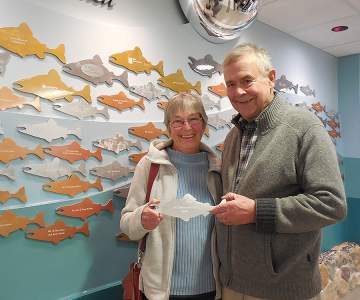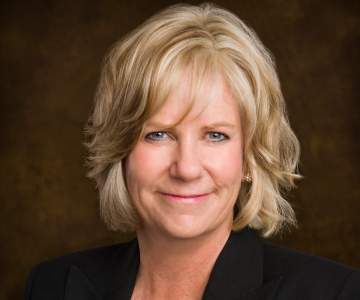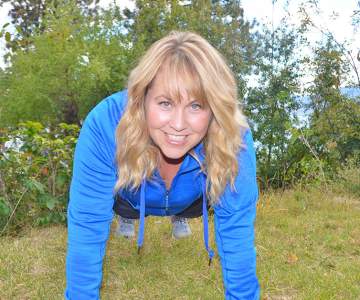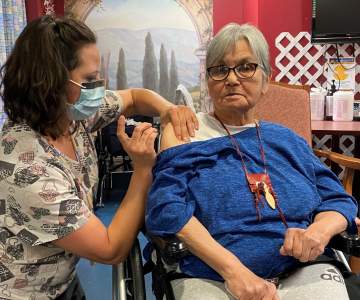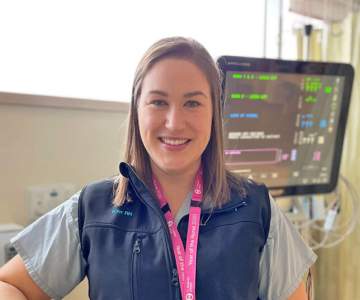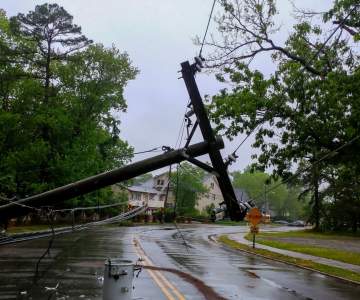Breadcrumb
Explore Stories
Research & Innovation
Retired Salmon Arm physician Brian Ayotte is thrilled Shuswap Lake General Hospital (SLGH) will be establishing a new, full scope mammography program.
The former cardiologist and past-president of the Shuswap Hospital Foundation (SHF), Brian lost his wife Gail to breast cancer last April. Like most breast health patients, she spent time travelling to either Vernon or Kamloops for service.
“Gail developed a malignant breast lump in 2013 at the age of 71, which meant a couple of trips to Kamloops for surgery and several trips to Vernon for follow-up mammography over seven years,” he says.
The cancer returned last Christmas, which required several more out-of-town trips for treatment.
“It complicated things not having the services in Salmon Arm,” Brian says, noting that, for many with breast cancer, the travel causes a great deal of discomfort.
Following Gail’s death, Brian asked that all funds donated to the foundation in her memory be directed toward a breast health program.
Over the next several years, that new program will become a reality, relying on the dedication of people like Brian to give back to the community. The Shuswap Hospital Foundation has kicked off a fundraising campaign for a new mammography program and the purchase of a new CT scanner for SLGH. The Ministry of Health approved and the SHF has kicked off its campaign called Here We Grow. The two new additions will come with price tag of $4.4 million and the foundation will provide 75 per cent of the funding.
Once the new program is up and running the Province’s mobile mammography unit will no longer come to the Shuswap as patients will be able to have regular screening at the hospital throughout the year. And if a patient finds a lump in their breast or irregular screening shows the need for further follow-up imaging, they will be able to get that in Salmon Arm.
The fundraising campaign, the foundation’s portion is $3.3 million, has already received serious community support.
Thanks to some very generous family donations and one who has chosen to remain anonymous, the foundation already has $2.2 million committed to this project. Donations were received from the estate of Robert Haney – $500,000; the estate of Geoffrey Collins – $591,950; the estate of Don Hilton –$149,299; the estate of Evelyn Painter – $415,911; and an anonymous donation of $350,000.
“We are so thrilled to be moving forward to help raise more funds for these two important projects,” said Shuswap Hospital Foundation president Angela Spencer. “We have such great support from the community and we have no doubt people will step up for our hospital once again. We are looking forward to supporting these enhancements to patient care at SLGH.”
Along with the mammography program, the foundation will raise money for a replacement CT scanner as the current machine, purchased with funds raised from the SHF in 2009, is reaching its end of life.
Exact timelines are still to be determined, however the CT scanner project is expected to be complete by 2022 and the mammography program by 2023.To support the foundation’s Here We Grow campaign, go online to shuswaphospitalfoundation.org, call 250-803-4546, or mail a cheque to the Shuswap Hospital Foundation, P.O. Box 265, Salmon Arm, B.C. V1E 4A7.
Community & Culture
The following statement from Susan Brown, Interior Health president & CEO, is in response to the report released Feb. 4, 2020 by Mary Ellen Turpel-Lafond.
The important work led by Mary Ellen Turpel-Lafond to investigate the extent to which Indigenous-specific racism exists in our health system, must mark a turning point for our province and our region.
Although it is difficult to hear and read the results of the investigation, and to understand the significant impacts of racism in the lives of First Nation and Métis people living in the southern Interior, it is also what drives us to change. We now have an accountability to respond.
I want to thank every person who shared their story and who contributed their experiences to Ms. Turpel-Lafond’s review, which was summarized in the In Plain Sight report released in November and was further detailed in the report released today.
Addressing Indigenous racism and discrimination is a priority for Interior Health. We are committed to working together with our First Nation and Métis partners to ensure each person who receives care and services from IH is treated with respect, dignity and compassion.
Health & Wellness, Research & Innovation
It still had that “new car” smell.
That was one of the first impressions Oliver resident Lars (last name withheld by request) had when he arrived at Penticton Regional Hospital’s new emergency department (ED) after an unfortunate early morning car accident on Feb. 2.
As a precaution, Lars was taken to PRH to be checked out and, as luck would have it, ended up being the first patient in a new section of the PRH ED, which had opened the same day.
The new care space is one of several phases of the emergency department renovation that will open this year. Already open is a new patient registration area, exam room and waiting area, but this marked the first major patient care area to open, with new exam bays and trauma rooms.
“They were all separate rooms; they were not just curtained off,” said Lars, 64, referencing the new exam bays – all private, single-patient rooms with sliding doors, enhancing patient privacy and improving infection prevention and control measures.
To have a private room in a place where there is so much activity, sometimes of a sensitive nature, is very important, added Lars.
“From a patient perspective, many times in the curtained rooms you can hear what is happening next door and it can be unnerving for the other patients and there is information being exchanged that other people shouldn’t be privy to,” he said.
The enhancements to the PRH ED are part of Phase 2 of the David E. Kampe Tower Project, a major renovation to the emergency department as well as the PRH pharmacy and material stores. The complex project is taking place in phases to keep the ED open to patients during construction. Now that this new care space has opened, work has moved into another area of the old department, with more care spaces set to open later this year.
“I was quite impressed,” said Lars, who was treated and released and was back at work the next day. “It was very high tech with new equipment and the care was excellent.”
The Phase 2 project will complete in early 2022.
“We’re very excited to have these new care spaces open in our emergency department,” said Sara Evans, Director of Clinical Operations at PRH. “The rooms are more private for patients, and they’re going to benefit from the new equipment and technology. I know our team provides such great care already – it’s going to be even better now, in this beautiful new space.”
What’s new in the PRH ED:
• 10 new patient spaces: two trauma bays, two isolation rooms, six standard exam bays
• Medication room
• Staff lounge
• Clean supply room
• Equipment supply room
• Patient Care Coordinator office and teaching space
• On-call physician space
• Family waiting room
• Patient registration and exam bay
• Waiting room
Community & Culture
We are IH is a recognition campaign to spotlight Interior Health employees and medical staff – through pictures and stories.
Name: Alicia Cardiff
Worksite: Dr. Andrew Pavilion, Recreation Department, Summerland
Years of Service: 1
Job Title: Recreation Therapy Assistant
As a Recreational Therapist, it's more than helping clients strengthen their physical, social and cognitive capabilities. It's about engaging with clients and bringing a smile to their faces.
To help us celebrate Recreational Therapist Month, Alicia, a Recreational Therapy Assistant with Dr. Andrew Pavilion in Summerland, shares her journey to finding her passion for helping others through her work.
Alicia’s love for fitness ignited at the young age of 16, as she became a certified lifeguard and fitness instructor. Working in city pool facilities in the Okanagan, Vancouver and Nanaimo, Alicia gained first-hand experience in recreation. Inspired to learn more, she pursued a diploma in Recreation Service at Langara College followed by a Bachelor of Recreation in Nanaimo.
Alicia was able to utilize her education and experience to pursue her passion of travel, as she taught backcountry safety awareness for BC Search and Rescue throughout the province. When she wasn’t touring BC, she was travelling the world, including a period of her life living in Ireland.
Upon accepting the position of Recreation Therapy Coordinator at Sun Point Village in 2006, Alicia brought a wealth of knowledge and experience to long-term care for Baptist Housing. Eager to expand her knowledge, she furthered her education at the University of Calgary in the Community Rehab Program. This highlighted her passion for seniors, including a focus on fall prevention and becoming a certified senior’s fitness instructor and personal trainer. Passionate about engaging with those with dementia in meaningful activation to help minimize their responsive behaviours, Alicia’s next career goal is to become a certified dementia care consultant. This would allow her to offer education to people in long-term care, their family, and staff, helping others provide the best possible care.
Alicia took a step back from work to focus on starting her family with her husband in Peachland, where she was also born and raised. Now that her two boys are 5 and 6 years old, Alicia wanted to return to work close to home.
Intrigued by the smaller size facility with more one-on-one time, she accepted a casual position at Interior Health with Dr. Andrew Pavilion. The love that Alicia has for her job is admirable, as she notes that if she won the lottery she would still love to continue her work.
Grateful to have the opportunity to help others, Alicia brings a positive outlook to her work and life. Located in the Okanagan, Alicia is able to continue to pursue her outdoor lifestyle, with 27 years of snowboarding under her belt, a passion for hiking, training for triathlons and tending to her ever-growing garden. Her energetic personality and sense of humour brings life to everyone around her. Thank you for all that you do!
Stay updated with careers at Interior Health
Facebook: Interior Health | Instagram: interiorhealthbc
| LinkedIn: Interior Health Authority
Health & Wellness
In This Together is a series dedicated to the stories of people contributing to our COVID-19 response. The following story is an account from Spotted Fawn Minnabarriet, a public health nurse with Interior Health.
S7entsa Spotted Fawn Minnabarriet, squza7sa s7 Eleanor Wells muta7 Larry Gordon, Lilwat7ulmeckan, muta7 St’at’imc (My name is Spotted Fawn Minnabarriet of the Lil’wat nation in the St’at’imc territory. My parents are Eleanor Wells and Larry Gordon).
I am honoured to be delivering the vaccine to help stop the spread of COVID-19. Providing the vaccine to St'at'imx Elder Rose Casper was a profound moment in my career because protecting our knowledge keepers is a very important teaching I hold from my upbringing. She is a respected Elder who I look up to as she set the path for not only Aboriginal nurses but St’at’imc nurses.
Rose Casper, Nurse and Knowledge Keeper
Rose Casper, pictured here in 1950, was the first Aboriginal nurse in Western Canada. She retired in 2013 after more than 50 years of service providing care in the Shalath community located at Seton Lake near Lillooet. In January 2021, Spotted Fawn provided Rose with the COVID-19 vaccine at her home at Mountain View Lodge.
I trust in the process of vaccine development and I have been following the covid-19 vaccine closely; I know that it is safe because I know that the world's greatest minds came together to learn about this virus and learn how to use existing technology and resources in order to develop safe and effective vaccines.
Receiving the COVID-19 vaccine means a great deal to me because I know I can keep my family, community, and clients safe from this virus. I am confident this is one step closer to beating this global pandemic.
I come from a large family, who lives in a small First Nations community called Mount Currie, and is rich in culture and tradition. I was named in a sweat lodge ceremony. We are taught to take good care of each other and to help others as much as we can. Before entering school to become a nurse I knew I was meant to help others – that was just the way it was.
I understand the impact COVID-19 can have in a small community, where most community members are family. Part of my family culture is gathering with family and friends in ceremony. Getting back to that is important to me. Not being able to attend gathering or ceremonies has given me much more of an appreciation for them in the last year. The thought of gathering in a safe way again brings me hope and joy.
Health & Wellness
Last year saw the launch of an investigation into Indigenous-specific racism in the B.C. health-care system, bringing new focus on Aboriginal health and wellness. As health-care providers look to implement the In Plain Sight Report recommendations, the Interior Voices podcast provides resources for improving culturally-safe care.
Launched in 2019, the Interior Voices podcast is an informal, ongoing conversation around cultural safety and Aboriginal health. Now entering its third season, the series has become an important educational resource for our care teams. The podcast also offers a glimpse into the people and programs within Interior Health which support this important area of care.
Interested in learning more? Check out these highlights:
Season 2 Episode 7: Orange Shirt Day and Trauma-Informed PracticeSeason 1 Episode 2: Traditional Territory Acknowledgements Season 1 Episode 21: IH Board Chair Dr. Doug Cochrane Season 2 Episode 5: Karen Cooper, Director of Allied Health for IH West Season 2 Episode 9: Thompson Rivers University Aboriginal Research Project Season 2 Episode 2: United Nations Declaration on the Rights of Indigenous Peoples (UNDRIP) Season 2 Episode 1: Truth and Reconciliation Commission (TRC) Season 1 Episode 13: IH Aboriginal Recruitment and Retention In Plain Sight: Addressing Indigenous-specific Racism and Discrimination in B.C. Health Care News@IH Story: Creating Welcoming Spaces
Community & Culture
We are IH is a recognition campaign to spotlight Interior Health employees and medical staff – through pictures and stories.
Name: Kim Forsyth
Worksite: Kelowna General Hospital
Years of Service: 11
Job Title: Clinical Practice Educator for Post-Anesthesia Recovery Room
Quote: "Nothing can dim the light that shines from within" - Maya Angelou.
As the first face they see as they awaken from surgery, patients are greeted with Kim's warm and welcoming smile. Her kind demeanour puts people at ease as she guides them through the post-anesthesia recovery.
“Post-anesthesia recovery is a unique part of a patient’s journey that not many people get to see. When my patients first wake up, it is a sense of relief, happiness, and positivity. It’s the first step of the recovery phase.” - Kim Forsyth, Clinical Practice Leader for PeriAnesthesia Recovery, Kelowna General Hospital
To help us celebrate PeriAnesthesia Nurses Week, Kim reminiscences on her journey to finding what she calls her "happy place" in the Post-Anesthesia Recovery room. Working at Kelowna General Hospital for over 11 years, she brings a wealth of knowledge and experience to her role overseeing and assisting with the education of all staff in the Post-Anesthesia Recovery department. Her enthusiastic personality shines through her work as she inspires her team to have fun as they learn with an interactive approach, such as the beloved game of Jeopardy.
Kim's proudest moment at Interior Health is advancing to her long-time career aspiration of being a clinical practice educator for PeriAnestheisa Recovery. Young Kim was always lending a helping hand, caring for others and playing nurse with her friends and family. At a young age, she knew that she wanted to pursue her passion for helping and teaching others, but she wasn't quite sure if that was as a teacher or a nurse. During a presentation by a group of nurses on health-care careers at her school in Grade 9, a lightbulb went on and Kim knew that becoming a nurse was the career she wanted to pursue.
As her career developed, she found a niche as a clinical practice educator where she could blend her two passions; nursing and teaching. Growing up very close with her family in Kelowna, she wanted to stay in close proximity as she pursued her Bachelor of Science as a Registered Nurse at the University of British Columbia Okanagan Campus.
Eager to put her education into practice, she pursued a career at Interior Health working in the Intensive Care Unit at Kelowna General Hospital as a Critical Care Nurse. Following her curiosity in the vast field of nursing, she felt a sense of excitement as she rolled her patients into the PostAnesthesia recovery room. Her interest was sparked further as her friendly co-worker welcomed Kim with a short tour and explanation of the wonderful world of PostAnesthesia Recovery. With the support of her family, co-workers, and management, she followed her curiosity and found her "happy place" in the PostAnesthesia Recovery room.
"Follow your curiosity, learn what you are passionate about, find what inspires you and take the leap! There are so many career opportunities out there and you can find one that you love." - Kim Forsyth, Clinical Practice Leader for PeriAnesthesia Recovery, Kelowna General Hospital
As the COVID-19 pandemic brought a lot of change, it affected Kim both personally and professionally. As a leader, she adjusted and guided her team through these changes in the workplace to ensure a safe experience for all.
With perseverance and a positive attitude, Kim has helped navigate her team throughout the ongoing pandemic, but she is looking forward to it being over. The pandemic created another shift in her personal life as she found another passion of hers. With new restrictions in place, she was unable to catch up with a friend over lunch, so they decided to find a new way to connect while snowshoeing. Her love of the outdoors grew as she discovered the world of snowshoeing while taking in the scenic views of the Okanagan.
When Kim isn’t teaching others, making her patients smile, or snowshoeing on mountain tops, you can find her cozy at home, quilting. Inspired by her mom's hobby as a quilter, they bonded over this creative hobby creating memories and quilts.
Kim believes happiness, positivity, and perseverance are essential to everyday life. Kim applies the determined, ambitious, and positive connotation of this quote to all aspects of her life and job: work hard, be kind and always help others along the way. Thank you for sharing your story and celebrating PeriAnestheisa Nurses week with us. The work you do is incredible and we are so grateful!
Nominate your colleagues to keep the We Are IH loop going:
Name: Christie Cornell
Message: Christie was the kind and welcoming nurse working in the PostAnesthesia Recovery room the day I realized how I wanted to advance my career. I credit where I am now to her!
For more information contact EmployeeExperience@InteriorHealth.ca.
Stay updated with careers at Interior Health
Facebook | Instagram | LinkedIn
Community & Culture
Odds are low that on any given day, a real emergency situation will arise. But Jane Power, director of clinical operations in Trail, has defied those odds a couple of notable times.
A year ago on New Year’s Eve, a winter storm knocked out power at the Arrow Lake Hospital in Nakusp. Thankfully the back-up generator kicked into gear and all was well. Until 3:00 a.m. when the house generator failed and the lights went out. Despite heroic efforts by the maintenance team, the generator would not restart, and the building remained dark.
The power outage caused a series of other problems. The doors of the connected long term care home were locked in the open position, so people prone to wandering might have left the building. The hospital's phone and internet systems were out of service. Without electricity, the building would have no heat, and the temperature of medication refrigerators was at risk.
Jane was the manager-on-call in the area that night. When she learned about the emergency, she jumped into action and started making a series of late night phone calls to address the problems and coordinate resources.
By mid-morning, Jane and her team had located another generator -- on New Year’s Day no less, and made arrangements to transfer all people living in long term care to a new place.
Fortunately, power was restored early the next afternoon, and no one needed to leave their home.
Would you be ready to manage such an emergency?
Later that year and once again the manager-on-call, Jane got the call when the water supply to Kootenay Boundary Regional Hospital stopped. This caused immediate problems for the renal program, threatened the hospital's ability to carry through with planned surgeries, and was going to cause problems for those living and working at nearby Poplar Ridge long term care home.
Jane and her team immediately arranged drinking water and planned for shutdowns to certain hospital programs. Fortunately, water pressure was restored sooner than expected and those disruptions were minimal.
Jane Power laughs when she is asked to share what she's learned about emergency response.
“You need to respond quickly, you can’t manage everything yourself, and you need to pull together the right people so there are different voices and experiences trying to solve the problem," says Jane. “People are so generous. Everybody answers their phones – even in the middle of the night on New Year’s Eve. IH has amazing people.”
In the everyday bustle of health care, unusual circumstances can happen. Emergencies of this size don't happen often, but when they do, it's reassuring to know there emergency response plans in place for each Interior Health location, and people like Jane to lead us through them.
Want to be like Jane? Check out our career choices!
Community & Culture
With the December holidays quickly approaching, University Hospital of Northern B.C. was dealing with challenging staffing issues. This normally busy hospital was feeling increasingly stretched as the number of patients with COVID-19 continued to grow. In some departments, nurses were taking more shifts that they would have liked in order to keep up with demand. Many of them were in need of some time off to recharge and be with their families over the holidays.
When Northern Health reached out for support and asked if nurses in other health authorities might be willing to to help, a group of four intensive care unit (ICU) nurses answered the call.
One of the people to respond was Sarah Bullock, a nurse from Kootenay Boundary Regional Hospital in Trail.
Sarah Bullock
“I think we are all in this together", says Sarah. "If our hospital was hit by COVID and we needed support, I would hope skilled nurses would be there for us too.”
“Since the pandemic started, I have felt a sense of camaraderie with nurses across the world", says Sarah. "Our community has been fortunate, and I wanted to support those fellow nurses who were struggling under difficult circumstances.”
Like most health-care workers, nurses are experiencing the pandemic in both their professional and personal lives.
"I'm really proud of the professionalism and generosity these nurses showed by responding to the call for support from our neighbors to the north" says Crystal White, director of Interior Health's critical care network and trauma services network. "Sarah Bullock, Taryn Kehler, Taaryn Miller, and Mallory Shofield have reminded me that there are so many ways we can be there for each other."
Since the pandemic began, the critical care network has been busy supporting and coordinating the ICU capacity to meet the need of our communities. "The hours have been long and at times tiring, but when I see nurses travel away from home over the holidays to support another community, it puts my own efforts into perspective, says Crystal. These nurses personify my idea of a frontline hero."
When asked for her thoughts on how others might show support, Sarah is quick to say "I think we all need to be kind to one another. Everyone has their reasons for doing what they are doing and I think most of us are doing our best to play by the rules and survive these crazy times."
-
Load More
Showing 666 of 796
Sign up for email updates
Receive news, alerts, public service announcements and articles right to your inbox.


